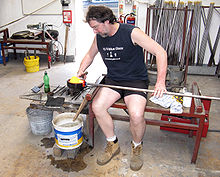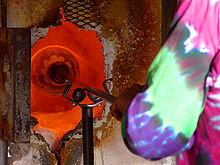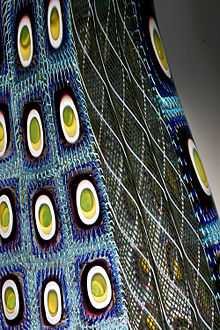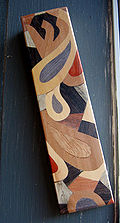- Glassblowing
-
 Glassblower Jean-Pierre Canlis (right) sculpting a section of his piece "Insignificance."
Glassblower Jean-Pierre Canlis (right) sculpting a section of his piece "Insignificance."
 A stage in the manufacture of a Bristol blue glass ship’s decanter. The blowpipe is being held in the glassblower's left hand. The glass is glowing yellow.
A stage in the manufacture of a Bristol blue glass ship’s decanter. The blowpipe is being held in the glassblower's left hand. The glass is glowing yellow.
Glassblowing is a glassforming technique that involves inflating molten glass into a bubble, or parison, with the aid of a blowpipe, or blow tube. A person who blows glass is called a glassblower, glassmith, or gaffer.
Contents
Technology
Principles
As a novel glass forming technique created in the middle of the last century BC, glassblowing exploited a working property of glass which was previously unknown to the glassworkers: inflation. Inflation refers to the expansion of a molten blob of glass by introducing a small amount of air to it. This property is based on the liquid structure of glass where the atoms are held together by strong chemical bonds in a disordered and random network,[1][2][3] therefore molten glass is viscous enough to be blown and gradually hardens as it loses heat.[4] In order to increase the stiffness of the molten glass, which in turn facilitates the process of blowing, there is a subtle change in the composition of glass. With reference to their studies of the ancient glass assemblages from Sepphoris of Israel, Fischer and McCray[5] postulated that the concentration of natron, which acts as flux in glass, is slightly lower in blown vessels than those manufactured by casting. Lower concentration of natron would have allowed the glass to be stiffer for blowing.
During blowing, thinner layers of glass cool faster than thicker ones and become more viscous than the thicker layers. This allows production of blown glass with uniform thickness, instead of facilitating blow-through of the thinned layers.
A full range of glassblowing techniques was developed within decades of its invention and the two major methods of glassblowing are as follows:
Free-blowing
This method held a pre-eminent position in glassforming ever since its introduction in the middle of the 1st century BC until the late 19th century and is still widely used nowadays as a glassforming technique. The process of free-blowing involves the blowing of short puffs of air into a molten portion of glass called a gather which is has been spooled at one end of the blowpipe. This has the effect of forming an elastic skin on the interior of the glass blob that matches the exterior caused by the removal of heat from the furnace. The glassworker can then quickly inflate the molten glass to a coherent blob and work it into a desired shape.[4][6][7] The Toledo Museum of Art attempted to reconstruct the ancient free-blowing technique by using clay blowpipes. The result proved that short clay blowpipes of about 30–60 cm facilitate free-blowing because they are simple to handle, easy to manipulate and can be re-used several times.[8] Skilled workers are capable of shaping almost any vessel forms by rotating the pipe, swinging it and controlling the temperature of the piece while they blow. They can produce a great variety of glass objects, ranging from drinking cups to window glass.
An outstanding example of the free-blowing technique is the Portland Vase which is a cameo manufactured during the Roman period. An experiment was carried out by Gudenrath and Whitehouse[9] with the aim of re-creating the Portland Vase. A full amount of blue glass required for the body of the vase was gathered on the end of the blowpipe and was subsequently dipped into a pot of hot white glass. Inflation occurred when the glassworker blew the molten glass into a sphere which was then stretched or elongated into a vase with a layer of white glass overlying the blue body.
Mold-blowing
Mold-blowing was an alternate glassblowing method that came after the invention of free-blowing during the first part of the second quarter of the 1st century AD[10][11] A glob of molten glass is placed on the end of the blowpipe which is then inflated into a wooden or metal carved mold. In this way, the shape and the texture of the bubble of glass is determined by the design on the interior of the mold rather than the skill of the glassworker.[4] Two types of molds, namely single-piece mold and multi-piece mold, are frequently used to produce mold-blown vessels. The former allows the finished glass object to be removed in one movement by pulling it upwards from the single-piece mold and is largely employed to produce tableware and utilitarian vessels for storage and transportation.[12] Whereas the latter is made in multi-paneled mold that join together, thus permitting the development of more sophisticated surface modeling, texture and design. The Roman leaf beaker which is now on display in the J. Paul Getty Museum was blown in a three-part mold decorated with the foliage relief frieze of four vertical plants.[13] Meanwhile, Taylor and Hill[14] tried to reproduce mold-blown vessels by using three-part molds made of different materials. The result suggested that metal, in particular bronze, molds are more effective in producing high-relief design on glass than plaster molds and wooden molds. In view of this, the development of the mold-blowing technique has enabled the speedy production of glass objects in large quantity, thus encouraging the mass production and widespread distribution of glass objects.[11][15]
In modern context
The transformation of raw materials into glass takes place around 2400 °F (~1315 °C); the glass emits enough heat to appear almost white hot. The glass is then left to "fine out" (allowing the bubbles to rise out of the mass), and then the working temperature is reduced in the furnace to around 2000 °F (~1100 °C). At this stage, the glass appears to be a bright orange color. Though most glassblowing is done between 1600 and 1900 °F (~870 to ~1040 °C), "Soda-lime" glass remains somewhat plastic and workable as low as 1350 °F (~730 °C). Annealing is usually done between 700 and 900 °F (~370 to ~480 °C).
Glassblowing involves three furnaces. The first, which contains a crucible of molten glass, is simply referred to as "the furnace." The second is called the "glory hole", and is used to reheat a piece in between steps of working with it. The final furnace is called the "lehr" or "annealer", and is used to slowly cool the glass, over a period of a few hours to a few days, depending on the size of the pieces. This keeps the glass from cracking due to thermal stress. Historically, all three furnaces were contained in one, with a set of progressively cooler chambers for each of the three purposes. Many glassblowing studios in Mexico and South America still employ this method.
 Items from the glass lab at the Massachusetts Institute of Technology
Items from the glass lab at the Massachusetts Institute of Technology
The major tools involved are the blowpipe (or blow tube), the punty (or pontil), bench, marver, blocks, jacks, paddles, tweezers, paper, and a variety of shears. The tip of the blowpipe is first preheated; then dipped in the molten glass in the furnace. The molten glass is 'gathered' on to the blowpipe in much the same way that honey is picked up on a dipper.
This glass is then rolled on the marver (marvering[16]), which was traditionally a flat slab of marble, but today is more commonly a fairly thick flat sheet of steel. This forms a cool skin on the exterior of the molten glass and shapes it. Then air is blown into the pipe, creating a bubble. Then, one can gather over that bubble to create a larger piece. Blocks are ladle-like tools made from water-soaked fruit wood and are used similarly to the marver to shape and cool a piece in the early steps of creation. The bench is a glassblower's workstation, and has a place for the glassblower to sit, a place for the handheld tools, and two rails that the pipe or punty rides on while the blower works with the piece. Jacks are a tool shaped somewhat like large tweezers with two blades. Jacks are used for forming shape later in the creation of a piece. Paddles are flat pieces of wood or graphite used for creating flat spots such as a bottom. Tweezers are used to pick out details or to pull on the glass. There are two important types of shears, straight shears and diamond shears. Straight shears are essentially bulky scissors, used for making linear cuts. Diamond shears have blades that form a diamond shape when partially open. These are used for cutting off masses of glass. Once a piece has been blown to its approximate final size, the bottom is finalized. Then, the molten glass is attached to a stainless steel or iron rod called a punty (or a punty rod, a pontil, or a mandrel) for shaping and transferring the hollow piece from the blowpipe to provide an opening and/or to finalize the top. There are many ways to apply patterns and color to blown glass, including rolling molten glass in powdered color or larger pieces of colored glass called frit. Complex patterns with great detail can be created through the use of cane (rods of colored glass) and murrine (rods cut in cross-sections to reveal patterns). These pieces of color can be arranged in a pattern and 'picked up' by rolling a bubble of molten glass over them. One of the most exacting and complicated caneworking techniques is 'reticello', which involves creating two bubbles from cane, each twisted in a different direction and then combining them and blowing out the final form.
A lampworker, usually operating on a much smaller scale, historically used alcohol lamps and breath or bellows-driven air to create a hot flame at a workbench to manipulate preformed glass rods and tubes. These stock materials took form as laboratory glassware, beads, and durable scientific "specimens"—miniature glass sculpture. The craft, which was raised to an art form in the late 1960s by Hans Godo Frabel (later followed by lampwork artists such as Milon Townsend and Robert Mickelson), is still practised today. The modern lampworker uses a flame of oxygen and propane or natural gas. The modern torch permits working both the soft glass from the furnace worker and the borosilicate glass (low-expansion) of the scientific glassblower who may have multiple headed torches and special lathes to help form the glass or fused quartz used for special projects.
History
Origins
Glassblowing is a glass forming technique which was invented by the Phoenicians at approximately 50 BC somewhere along the Syro-Palestinian coast. The earliest evidence of glassblowing comes from a collection of waste from a glass workshop, including fragments of glass tubes, glass rods and tiny blown bottles, which was dumped in a mikvah, a ritual bath in the Jewish Quarter of Old City of Jerusalem dated from 37 to 4 BC[8][12][17] Some of the glass tubes recovered are fire-closed at one end and are partially inflated by blowing through the open end while still hot to form small bottle, thus they are considered as a rudimentary form of blowpipe.[9] Hence, tube blowing not only represents the initial attempts of experimentation by glassworkers at blowing glass, it is also a revolutionary step that induced a change in conception and a deep understanding of glass.[18] Such invention swiftly eclipsed all other traditional methods, such as casting and core-forming, in working glass.
In the Roman Empire
Main article: Roman glassThe invention of glassblowing coincided with the establishment of the Roman Empire in the 1st century BC which served to provide motivation to its spread and dominance.[4][19] Glassblowing was greatly encouraged under the Roman rule, although Roman citizens could not be "in trade", in particular under the reign of Augustus, therefore glass was being blown in many areas of the Roman world.[11][20] On the eastern borders of the Empire, the first glass workshops were set up by the Phoenicians in the birthplace of glassblowing in contemporary Lebanon, Israel, and Palestine, as well as in the neighbouring province of Cyprus.[12] Ennion for example, was among one of the most prominent glassworkers from Lebanon of the time. He was renowned for producing the multi-paneled mould-blown glass vessels that were complex in their shapes, arrangement and decorative motifs.[11][12][13] The complexity of designs of these mould-blown glass vessels illustrated that the sophistication of the glassworkers in the eastern regions of the Roman Empire. Mould-blown glass vessels manufactured by the workshops of Ennion and other contemporary glassworkers such as Jason, Nikon, Aristeas and Meges, constitutes some of the earliest evidence of glassblowing found in the eastern territories.[12][21] Meanwhile, the glassblowing technique reached Egypt and was described in a fragmentary poem printed on the papyrus which was dated to 3rd century AD[8][22] Besides, the Roman hegemony over the Mediterranean areas resulted in the substitution of Hellenistic casting, core-forming and mosaic fusion techniques by blowing.[1] The earliest evidence of blowing in Hellenistic consists of small blown bottles for perfume and oil retrieved from the glass workshops on the Greek island of Samothrace and at Corinth in mainland Greece which were dated to 1st century AD[12]
On the other hand, the Phoenician glassworkers exploited their glassblowing techniques and set up their workshops in the western territories of the Roman Empire first in Italy by the middle of the 1st century AD Rome, the heartland of the Empire, soon became a major glassblowing centre and more glassblowing workshops were subsequently established in other provinces of Italy, for example Campania, Morgantina and Aquileia.[1][12][23] A great variety of blown glass objects, ranging from unguentaria (toiletry container for perfume) to cameo, from tableware to window glass, were produced. From there, escaping craftsmen forbidden to travel otherwise advanced to the rest of Europe by building their glassblowing workshops in the north of the Alps which is now Switzerland and then at sites in northern Europe in present-day France and Belgium.[19][24][25] Surviving evidence, such as blowpipes and moulds which are indicative of the presence of blowing, was fragmentary and limited. Fragments of clay blowpipes were retrieved from the late 1st century AD glass workshop at Avenches in Switzerland.[8] Clay blowpipes, also known as mouthblowers, were made by the ancient glassworkers due to the accessibility and availability of the resources before the introduction of the metal blowpipes. Hollow iron rods, together with blown vessel fragments and glass waste dating to approximately 4th century AD, were recovered from the glass workshop in Merida of Spain, as well as in Salona in Croatia.[12][24] Meanwhile, one of the most prolific glassblowing centres of the Roman period was established in Cologne on the river Rhine in Germany by late 1st century BC. Stone base mould and terracotta base mould were discovered from these Rhineland workshops suggesting the adoption and the application of mould-blowing technique by the glassworkers.[13] Besides, blown flagons and blown jars decorated with ribbing, as well as blown perfume bottles with letters CCAA or CCA which stand for Colonia Claudia Agrippiniensis, were produced from the Rhineland workshops.[12][19][24] Remains of blown blue-green glass vessels, for example bottles with a handle, collared bowls and indented beakers, were found in abundance from the local glass workshops at Poetovio and Celeia in Slovenia.[26]
Middle Ages
The glass blowing tradition was carried on in Europe from the medieval period through the Middle Ages to the Renaissance in the demise of the Roman Empire in the 5th century AD. During the early medieval period, the Franks manipulated the technique of glassblowing by creating the simple corrugated moulds and developing the claws decoration techniques.[27][28] Blown glass objects, such as the drinking vessels that imitated the shape of the animal horn were produced in the Rhine and Meuse valleys, as well as in Belgium. On the other hand, the Renaissance Europe witnessed the revitalization of glass industry in Italy. Glassblowing, in particular the mould-blowing technique, was employed by the Venetian glassworkers from Murano to produce the fine glassware which is also known as cristallo.[29][30] The technique of glassblowing, coupled with the cylinder and crown methods, was used to manufacture sheet or flat glass for window panes in the late 17th century.[4] The applicability of glassblowing was so widespread that glass was being blown in many parts of the world, for example, in China, Japan and the Islamic Lands. The Byzantine glassworkers made mould-blown glass decorated with Jewish and Christian symbols in Jerusalem between late 6th century and the middle of the 7th century AD.[28][29] Mould-blown vessels with facets, relief and linear-cut decoration were discovered at Samarra in the Islamic Lands.[28]
Recent developments
The "studio glass movement" began in 1962 when Harvey Littleton, a ceramics professor, and Dominick Labino, a chemist and engineer, held two workshops at the Toledo Museum of Art, during which they started experimenting with melting glass in a small furnace and creating blown glass art. Littleton promoted the use of small furnaces in individual artists studios. This approach to glassblowing blossomed into a worldwide movement, producing such flamboyant and prolific artists as Dale Chihuly, Dante Marioni, Fritz Driesbach and Marvin Lipofsky as well as scores of other modern glass artists. Today there are many different institutions around the world that offer glassmaking resources.
See also
- Angel gilding
- Caneworking
- Flat glass
- Glassfusing
- Glass art
- Glass beadmaking
- Glass tiles
- Glass sculpture
- Lampworking
- List of glass artists
- Mosaic
- Murrine
- Paperweight
- Stained glass
References
- ^ a b c Frank, S 1982. Glass and Archaeology. Academic Press: London. ISBN 0122656202
- ^ Freestone, I. 1991. Looking into Glass. In S. Bowman (ed.) Science and the Past. pp.37–56. University of Toronto Press: Toronto & Buffalo. ISBN 0714120715
- ^ Pollard, A.M. and C. Heron 2008. Archaeological Chemistry. The Royal Society of Chemistry ISBN 0854042628
- ^ a b c d e Cummings, K. 2002. A History of Glassforming. University of Pennsylvania Press ISBN 0812236475
- ^ Fischer, A (1999). "Glass Production Activities as Practised at Sepphoris, Israel (37 ?–? 1516)". Journal of Archaeological Science 26 (8): 893. doi:10.1006/jasc.1999.0398.
- ^ Mariacher, G. 1970. Glass: from Antiquity to the Renaissance. The Hamlyn Publishing Group Limited: Middlesex.
- ^ Zerwick, C. 1980. A Short History of Glass. The Corning Museum of Glass Press; Corning, New York. ISBN 0810938014
- ^ a b c d Stern, E.M. & B. Schlick-Nolte 1994. Early Glass of the Ancient World 1600 BC – AD 50. Ernesto Wolf Collection. Verlag Gerd Hatje: Ostfildern.
- ^ a b Gudenrath, W. & D. Whitehouse 1990. The Manufacture of the Vase of its Ancient Repair. In Journal of Glass Studies 32: 108–121.
- ^ Lightfoot, C.S. 1987. A Group of early Roman Mould-Blown Flasks from the West. In Journal of Glass Studies 29: 11–18.
- ^ a b c d Price, J. 1991. Decorated Mould-Blown Glass Tablewares in the First century AD. In M. Newby & K. Painter (eds.) Roman Glass: Two Centuries of Art and Invention. pp. 56–75. The Society of Antiquaries of London: London ISBN 0854312552
- ^ a b c d e f g h i Tatton-Brown, V. 1991. The Roman Empire. In H. Tait (ed.) Five Thousand Years of Glass. pp.62–97. British Museum Press: London ISBN 0812218884
- ^ a b c Wright, K. 2000. Leaf Beakers and Roman Mould-blown Glass Production in the First Century AD. In Journal of Glass Studies 42: 61–82.
- ^ Taylor, M. & D. Hill 1998. Making Roman Glass Today. In The Colchester Archaeologist 11
- ^ Cuneaz, G. 2003. Introduction. In R.B. Mentasti, R. Mollo, P. Framarin, M. Sciaccaluga & A. Geotti (eds.) Glass Through Time: history and technique of glassmaking from the ancient world to the present. pp. 11–30. Skira Editore: Milan ISBN 9788884913456
- ^ Marvering
- ^ Avigad, N 1983. Discovering Jerusalem. Nashville. ISBN 0840752997
- ^ Israeli, Y. 1991. The Invention of Blowing. In M. Newby & K. Painter (eds.) Roman Glass: Two Centuries of Art and Invention. pp. 46–55. The Society of Antiquaries of London: London ISBN 0854312552
- ^ a b c Vose, R.H. 1989. Glass. Collins Archaeology: London. ISBN 0852237146
- ^ Isings, C. 1957. Roman Glass: from dated finds. Archaeologica Traiectina. J.B. Wolters: Groningen.
- ^ Hőricht, L.A.S. 1991. Syrian Elements among the Glass from Pompeii. In M. Newby & K. Painter (eds.) Roman Glass: two centuries of art and invention. pp. 76–85. The Society of Antiquaries of London: London ISBN 0854312552
- ^ Coles, R.A. 1983. The Oxyrhynchus Papyri 50. Egypt Exploration Society for the British Academy: London.
- ^ Grose, D.F. 1982. The Hellenistic and Early Roman Glass from Morgantina (Serra Orlando), Sicily. In Journal of Glass Studies 24: 20–29.
- ^ a b c Allen, D. 1998. Roman Glass in Britain. Shire Archaeology No. 76. CTT Printing Series Ltd.: Pembrokeshire.
- ^ Price, J. 2000. Roman Glass Production in Western Europe. In M-D Nenna (ed.) La Route Du Verre: ateliers primaries et secondaires du second millenaire av. J-C au Moyen Age. pp. 123–124. Maison de l’Orient Mediterranean: Paris
- ^ Lazar, I. 2006. Glass finds in Slovenia and neighbouring areas. In Journal of Roman Archaeology 19: 299–342.
- ^ Tatton-Brown, V. 1991. Early Medieval Europe AD 400 – 1066. In H. Tait (ed.) Five Thousand Years of Glass. pp. 98–111. British Museum Press: London. ISBN 0812218884
- ^ a b c Vose, R.H. 1989. From Dark Ages to the Fall of Constantinople. In D. Klein & W. Lloyd (eds.) The History of Glass. pp. 39–66. Macdonald & Co. (Publishers) Ltd.: ISBN 085613516X
- ^ a b Tait, H. 1994. Europe from the Middle Ages to Industrial Revolution. In H. Tait (ed.) Five Thousand Years of Glass. pp. 145–187. British Museum Press: London ISBN 0812218884
- ^ Wood, P. 1989. The Tradition from Medieval to Renaissance. In D. Klein & W. Lloyd (eds.) The History of Glass. pp. 67–92. Macdonald & Co. (Publishers) Ltd.: ISBN 085613516X
External links
- Glassblowing at the Open Directory Project
- Glass Education at the Open Directory Project contains additional glassblowing informational links
- A Brief History of Glass
- Scientific Glassblowing Basics a tutorial
Glass forming techniques Commercial techniques - Float glass process
- Blowing and pressing (containers)
- Extrusion / Drawing (fibers, glasswool)
- Drawing (optical fibers)
- Precision glass moulding
- Overflow downdraw method
- Pressing
- Casting
- Cutting
- Flame polishing
- Chemical polishing
- Diamond turning
- Rolling
Artistic and historic techniques - Beadmaking
- Blowing
- Blown plate
- Broad sheet
- Caneworking
- Crown glass
- Cylinder blown sheet
- Engraving
- Etching
- Fourcault process
- Fusing
- Lampworking
- Machine drawn cylinder sheet
- Millefiori
- Polished plate
- Slumping
- Stained glass fusing
- Stained glass production
See also Categories:- History of glass
- Glass forming
- Glass art
Wikimedia Foundation. 2010.







